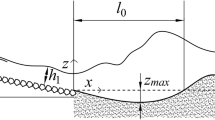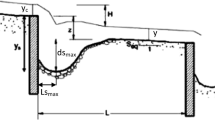Abstract
For an efficient restoration of ecological continuity, rock-ramp fishways with protruding blocks and lateral slope can allow to conciliate two opposite objectives: sufficiently low flow velocities in some parts of the ramp for fish passage and a large global discharge for attractiveness. Flows in such ramps with several lateral slopes (from 5% to 18.5%), longitudinal slopes (from 1% to 7%) and discharges were investigated experimentally on a one-fifth scale model and numerically with RANS and LES models, to check up their passability compared to ramps with no lateral slope. Results revealed that the methodology for assessing stage-discharge relationship and maximum velocities is still relevant whatever the lateral slope. However, as the lateral slope increases, so does the lateral deviation of the free surface, as well as the transverse and vertical velocities in the emergent part of the ramp, near the submerged part. This is why it appears preferable to limit the transversal slope to a maximum 12% in rock-ramp fishways with protruding blocks. This recommendation is already much higher than the one applied up to now in France (lower or equal to the longitudinal slope, so mostly lower or equal to 4% to 6%) and will allow to reduce the width and thus the cost of the ramp.
Highlights
-
CFD simulation with LES is pertinent to investigate flow in rock-ramp fishway with a transversal slope and protruding blocks either emergent or submerged.
-
Lateral slope up to 12% do not disturb flow in the part where blocks are emergent, which makes it possible to consider lower build-cost fishway.
-
Design procedure for rock-ramp fishway remains valid with lateral slopes with some precautions.



















Similar content being viewed by others
References
Amaral SD, Quaresma AL, Branco P, Romão F, Katopodis C, Ferreira MT, Santos AN (2019) Assessment of retrofitted ramped weirs to improve passage of potamodromous fish. Water 11:1–10
Amaral SD, Branco P, Romão F, Ferreira MT, Pinheiro AN, Santos JM (2021) Evaluation of low-head ramped weirs for a potamodromous cyprinid: effects of substrate addition and discharge on fish passage performance stress and fatigue. Water 13:765
Baki ABM, Zhu DZ, Rajaratnam N (2014) Mean flow characteristics in a rock-ramp-type fish pass. J Hydraul Eng 140:156–168
Baki ABM, Zhu DZ, Rajaratnam N (2016) Flow simulation in a rock-ramp fish pass. J Hydraul Eng 142:1–12
Baudoin JM, Burgun V, Chanseau M, Larinier M, Ovidio M, Sremski W, Steinbach P, Voegtle B (2014) Assessing the passage of obstacles by fish. Concepts, Design and Application Onema, Paris, France
Cassan L, Tien T, Courret D, Laurens P, Dartus D (2014) Hydraulic resistance of emergent macroroughness at large froude numbers: design of nature-like fishpasses. J Hydraul Eng 140:1–9
Cassan L, Miranda FC, Laurens P (2023) Hydraulic resistance in rock-ramps fish passes for several shapes of macro-roughness. J Hydraul Eng 149(2):456. https://doi.org/10.1061/JHEND8.HYENG-13096
Cassan L, Laurens P (2016) Design of emergent and submerged rock-ramp fish passes. Knowl Manag Aquat Ecosys 417:1–10
Chorda J, Cassan L, Laurens P (2019) Modeling steep-slope flow across staggered emergent cylinders: application to fish passes. J Hydraul Eng 145:1–14
Chorda J, Larinie M, Thinus Z (2004) A flume study of steep-slope flows above large-scale roughness elements and their applications to fish passes. In: 5th international symposium on ecohydraulics - aquatic habitats: analysis & restoration Madrid, Spain
Dorchies D, Chouet M, Grand F, Cassan L, Richard S, Courret D (2022) Cassiopee a software to bridge the gap between researchers and engineers in hydraulic calculations. In: Proceedings of the 39th IAHR world congress, Granada, Spain
Ducrocq T, Cassan L, Chorda J, Roux H (2017) Flow and drag force around a free surface piercing cylinder for environmental applications. Environ Fluid Mech 17:629–645
Golpira A, Baki AB, Zhu DZ (2020) Higher-order velocity moments, turbulence scales and energy dissipation rate around a boulder in a rock-ramp fish passage. Sustainability 12:5385
Larinier M, Courret D, Gomes P (2006) Technical guide to the concept on nature-like fishways. Rapport GHAAPPE RA.06.05-V1, 5
Miranda FC, Cassan L, Laurens P, Tran TD (2021) Study of a rock-ramp fish pass with staggered emergent square obstacles. Water 13:1175. https://doi.org/10.3390/w13091175
Pang ALJ, Skote M, Lim SY (2016) Modelling high Re flow around a 2D cylindrical bluff body using the k-w (SST) turbulence model. Prog Comput Fluid Dyn Int J 16(1):48–57. https://doi.org/10.1504/PCFD.2016.074225
Quaresma AL, Pinheiro AN (2021) Modelling of pool-type fishways flows: efficiency and scale effects assessment. Water 13:851. https://doi.org/10.3390/w13060851
Romdhane H, Soualmia A, Cassan L, Masbernat L (2017) Evolution of flow velocities in a rectangular channel with homogeneous bed roughness. Int J Eng Res 6(3):120–125
Silva AT, Bermúdez M, Santos JM, Rabuñal JR, Puertas J (2020) Pool-type fishway design for a potamodromous cyprinid in the Iberian Peninsula: the Iberian barbel-synthesis and future directions. Sustainability 12:3387
Smagorinsky J (1963) General circulation experiments with the primitive equations: I. The basic experiment. Mon. Weather Rev. 91:99–164
Tran TD, Chorda J, Laurens P, Cassan L (2016) Modelling nature-like fishway flow around unsubmerged obstacles using a 2D shallow water model. Environ Fluid Mech 16:413–428
Acknowledgements
The calculations were performed on the Olympe supercomputer at CALMIP, Toulouse, France, which is gratefully acknowledged (Project P20048).
Author information
Authors and Affiliations
Contributions
LC, FM and DC—wrote the manuscript. LC—computed discharge relationship and analysed results. FM—performed numerical simulations. PL—carried out experiments. All authors reviewed the manuscript.
Corresponding author
Ethics declarations
Conflict of interest
The authors declare no conflict of interest.
Additional information
Publisher's Note
Springer Nature remains neutral with regard to jurisdictional claims in published maps and institutional affiliations.
Rights and permissions
Springer Nature or its licensor (e.g. a society or other partner) holds exclusive rights to this article under a publishing agreement with the author(s) or other rightsholder(s); author self-archiving of the accepted manuscript version of this article is solely governed by the terms of such publishing agreement and applicable law.
About this article
Cite this article
Cassan, L., Miranda, F.C., Laurens, P. et al. Hydraulic of rock-ramp fishway with lateral slope. Environ Fluid Mech 24, 1–18 (2024). https://doi.org/10.1007/s10652-023-09958-6
Received:
Accepted:
Published:
Issue Date:
DOI: https://doi.org/10.1007/s10652-023-09958-6




